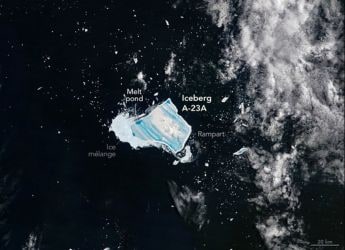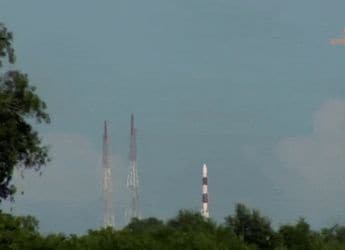- Home
- Science
- Science News
- NASA Publishes Images of Giant Meteor Explosion Over Bering Sea
NASA Publishes Images of Giant Meteor Explosion Over Bering Sea

Photo Credit: NASA
NASA has published the meteor images on its website
NASA on Friday published satellite photos of a powerful meteor which appeared just above the Bering Sea on December 18 but went unnoticed until months later. The explosion unleashed around 173 kilotons of energy, more than 10 times that of the atomic bomb blast over Hiroshima in World War II. Images captured minutes after the fireball disintegrated in the atmosphere show the shadow of the meteor's trail cast on top of clouds, elongated by the sun's low position.
The super-heated air turns the clouds to an orange tint in the meteor's wake.
The photographs were taken by two NASA instruments on board the Terra satellite.
The Terra spacecraft was launched in 1999 and is managed by NASA's Goddard Space Flight Center.
A still image was taken at 2350 GMT, while five of the of nine cameras on the Multi-angle Imaging SpectroRadiometer (MISR) instrument took another sequence of photos at 2355, which NASA collated into a GIF that shows the orange trail
NASA estimates that the meteor occurred at 23:48 GMT.
Meteors are rocks from outer space that become incandescent upon entering earth's atmosphere as a result of friction. They are also known as shooting stars. Pieces which survive intact and hit the ground are known as meteorites.
It was the most powerful explosion in the atmosphere since the fireball that burst over the Russian town of Chelyabinsk in 2013. That was 440 kilotons, and left 1,500 people injured, mostly from glass flying out of smashed windows.
This time around, the blast occurred over waters, hundreds of kilometres off the Russian coast.
The first photo of the event was taken by a Japanese weather satellite and published only this week.
Catch the latest from the Consumer Electronics Show on Gadgets 360, at our CES 2026 hub.
Related Stories
- Samsung Galaxy Unpacked 2025
- ChatGPT
- Redmi Note 14 Pro+
- iPhone 16
- Apple Vision Pro
- Oneplus 12
- OnePlus Nord CE 3 Lite 5G
- iPhone 13
- Xiaomi 14 Pro
- Oppo Find N3
- Tecno Spark Go (2023)
- Realme V30
- Best Phones Under 25000
- Samsung Galaxy S24 Series
- Cryptocurrency
- iQoo 12
- Samsung Galaxy S24 Ultra
- Giottus
- Samsung Galaxy Z Flip 5
- Apple 'Scary Fast'
- Housefull 5
- GoPro Hero 12 Black Review
- Invincible Season 2
- JioGlass
- HD Ready TV
- Laptop Under 50000
- Smartwatch Under 10000
- Latest Mobile Phones
- Compare Phones
- OnePlus Turbo 6V
- OnePlus Turbo 6
- Itel Zeno 20 Max
- OPPO Reno 15 Pro Mini 5G
- Poco M8 Pro 5G
- Motorola Signature
- Vivo Y50e 5G
- Vivo Y50s 5G
- Lenovo Yoga Slim 7x (2025)
- Lenovo Yoga Slim 7a
- Realme Pad 3
- OPPO Pad Air 5
- Xiaomi Watch 5
- Huawei Watch 10th Anniversary Edition
- Acerpure Nitro Z Series 100-inch QLED TV
- Samsung 43 Inch LED Ultra HD (4K) Smart TV (UA43UE81AFULXL)
- Asus ROG Ally
- Nintendo Switch Lite
- Haier 1.6 Ton 5 Star Inverter Split AC (HSU19G-MZAID5BN-INV)
- Haier 1.6 Ton 5 Star Inverter Split AC (HSU19G-MZAIM5BN-INV)

















